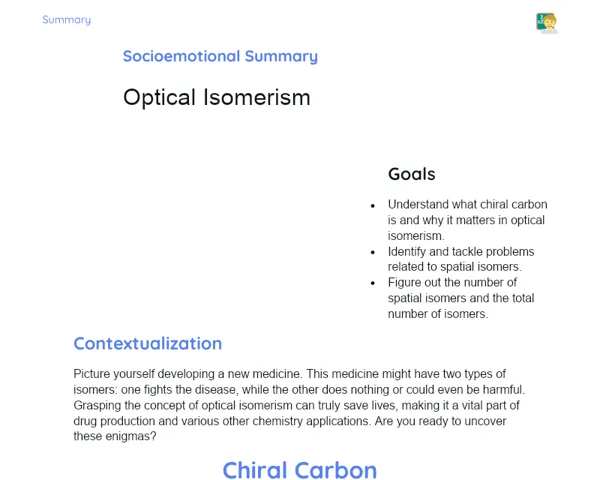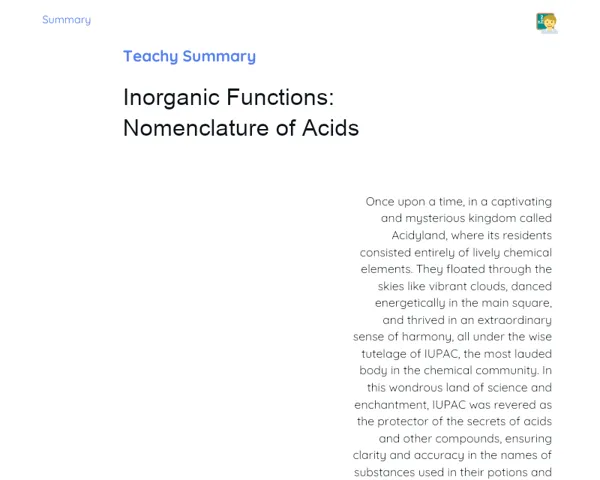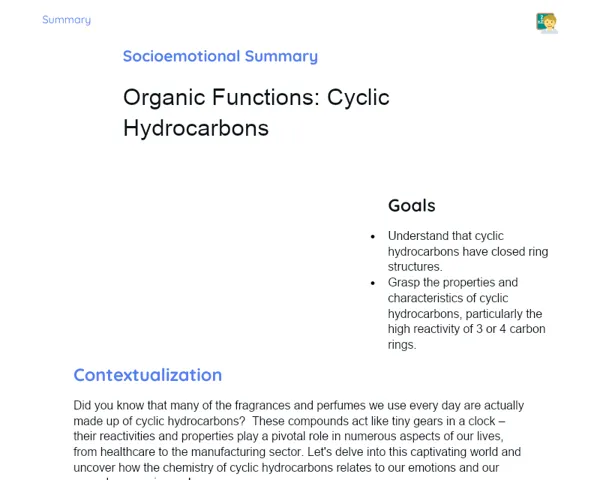Summary Tradisional | Inorganic Functions: Oxide Nomenclature
Contextualization
Oxides are chemical compounds that form when oxygen combines with other elements. These compounds are everywhere in our everyday lives and are crucial both in nature and in various industries. For instance, carbon dioxide (CO₂) is vital in the photosynthesis process in plants and in respiration of living organisms, while calcium oxide (CaO), commonly known as quicklime, is widely utilised in construction for making cement.
In the field of inorganic chemistry, we can group oxides into four main types: basic, acidic, amphoteric, and neutral oxides. This classification depends on the nature of the element that combines with oxygen, as well as how the oxide behaves with water and acids. Getting a grip on these classifications and the proper naming of oxides is key to tackling chemical problems and understanding their properties and real-world uses.
To Remember!
Definition of Oxides
Oxides are chemical compounds created when oxygen bonds with other elements. They can be represented by the general formula XO, where X stands for the element that is bonded to oxygen. Oxides are found commonly in nature and play significant roles in numerous chemical reactions and industrial applications. For instance, carbon dioxide (CO₂) emerges from cellular respiration and is used by plants during photosynthesis.
The formation of oxides happens when oxygen, which has a high electronegativity, reacts with other elements, resulting in stable compounds. The bond formed in the oxide can either be ionic or covalent, depending on the elements involved. Typically, metal oxides form ionic bonds, while non-metal oxides generally form covalent bonds.
Oxides are divided into different categories based on their chemical traits and behaviours. This classification aids in understanding the reactivity of oxides and their practical applications. For example, calcium oxide (CaO) is extensively used in the construction sector for producing cement and quicklime due to its basic properties.
-
Oxides are compounds created when oxygen combines with other elements.
-
They can exhibit ionic or covalent bonds based on the elements involved.
-
Classification is based on their chemical characteristics and behaviours.
Classification of Oxides
Oxides can be sorted into four primary categories: basic, acidic, amphoteric, and neutral oxides. This classification is determined by the nature of the element that interacts with oxygen and the oxide's response to water and acids.
Basic Oxides: Made from alkali and alkaline earth metals. These react with water to form bases or hydroxides. A common example is sodium oxide (Na₂O), which reacts with water to become sodium hydroxide (NaOH).
Acidic Oxides: Composed of non-metals and some transition metals in higher oxidation states. They react with water to produce acids. Sulfur trioxide (SO₃), for instance, reacts with water to form sulfuric acid (H₂SO₄).
Amphoteric Oxides: Capable of reacting with both acids and bases, producing salts and water. A fitting example is aluminium oxide (Al₂O₃), which can react with acid to produce AlCl₃ or with a base to form Na[Al(OH)₄].
Neutral Oxides: Do not undergo reactions with acids or bases. These are less prevalent; an example is carbon monoxide (CO).
-
Basic oxides react with water to yield bases.
-
Acidic oxides react with water to yield acids.
-
Amphoteric oxides react with both acids and bases.
-
Neutral oxides remain unreacted with acids and bases.
Nomenclature of Oxides
When it comes to naming oxides, specific rules apply that differ depending on the type of element forming the oxide. For oxides from metals with a single oxidation state, we simply use 'oxide' plus the name of the metal. For example, MgO is referred to as magnesium oxide.
In cases where metals have multiple oxidation states, we use the suffixes '-ous' and '-ic' to denote the lower and higher oxidation states, respectively. For example, FeO is known as ferrous oxide, whereas Fe₂O₃ is called ferric oxide.
For non-metal oxides, Greek numerical prefixes indicate the number of atoms present in the compound. For example, CO is carbon monoxide, and CO₂ is carbon dioxide. These naming conventions are crucial for correctly identifying and distinguishing between compounds.
Mastering the nomenclature of oxides is vital for effective communication in chemistry, facilitating the precise identification and examination of compounds and their reactions.
-
For metals with a single oxidation state, use 'oxide' followed by the metal's name.
-
For metals with multiple oxidation states, use the suffixes '-ous' and '-ic'.
-
Non-metal oxides apply Greek numeral prefixes.
Practical Examples and Problem Solving
Applying examples and solving problems are essential to reinforce the understanding of oxide nomenclature. Take, for example, the compound Cu₂O. Copper exists in two common oxidation states: +1 and +2. In Cu₂O, copper is in the +1 oxidation state, earning it the name cuprous oxide. Conversely, CuO has copper in the +2 oxidation state and is therefore termed cupric oxide.
Another instance is Fe₂O₃. Here, iron has oxidation states of +2 and +3. In Fe₂O₃, iron is in the +3 oxidation state, so it is called ferric oxide. These instances highlight the practical application of naming rules and the significance of accurately identifying elements' oxidation states.
Guided problem-solving during lessons can significantly aid students in grasping the process of naming oxides and applying the rules effectively. For example, when naming SnO and SnO₂, it is crucial to recognise that tin can have oxidation states of +2 and +4, resulting in stannous oxide and stannic oxide, respectively.
Such practical exercises help to consolidate students' understanding and equip them with the skills to navigate chemical challenges independently and effectively.
-
Example: Cu₂O is cuprous oxide (Cu+1).
-
Example: Fe₂O₃ is ferric oxide (Fe+3).
-
Practice and solving problems solidify knowledge.
Key Terms
-
Oxides: Compounds formed by the combination of oxygen with other elements.
-
Basic Oxides: Made from alkali and alkaline earth metals, reacting with water to create bases.
-
Acidic Oxides: Formed by non-metals and some transition metals in higher oxidation states, react with water to form acids.
-
Amphoteric Oxides: React with both acids and bases.
-
Neutral Oxides: Do not interact with acids or bases.
-
Nomenclature: System of rules for naming oxides.
-
Suffixes '-ous' and '-ic': Used for metals with different oxidation states, denoting lower and higher states.
-
Greek Numerical Prefixes: Indicate the number of atoms in non-metal oxides.
Important Conclusions
In this lesson, we unpacked the importance and definitions surrounding oxides in inorganic chemistry, noting how these compounds form through the interaction of oxygen with other elements. We explored the classification of oxides into four main categories — basic, acidic, amphoteric, and neutral — and the implications of these classifications for their reactions and practical use. Furthermore, we delved into the rules of naming oxides, using '-ous' and '-ic' for metals with multiple oxidation states and Greek numerical prefixes for non-metal oxides, with examples like FeO (ferrous oxide) and CO₂ (carbon dioxide).
Grasping the nomenclature and classification of oxides is vital for solving chemical problems and applying this knowledge across different fields, like industry and biology. For instance, being aware that calcium oxide (CaO) is utilised in construction, or that carbon dioxide (CO₂) is a key player in photosynthesis and respiration, underscores the real-world significance of the topic.
We encourage students to further explore this subject. Mastering the naming of oxides not only enhances their understanding of chemical reactions but also strengthens their overall skills in inorganic chemistry. This knowledge lays a solid foundation for academic success and future practical applications.
Study Tips
-
Review the practical examples discussed in class and attempt naming new oxides using the rules learned.
-
Complete extra exercises on naming and classifying oxides to strengthen understanding and identify any uncertainties.
-
Read scientific articles and educational resources about oxides and their applications to gain a deeper insight into their practical use.



